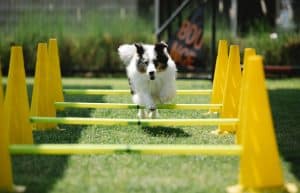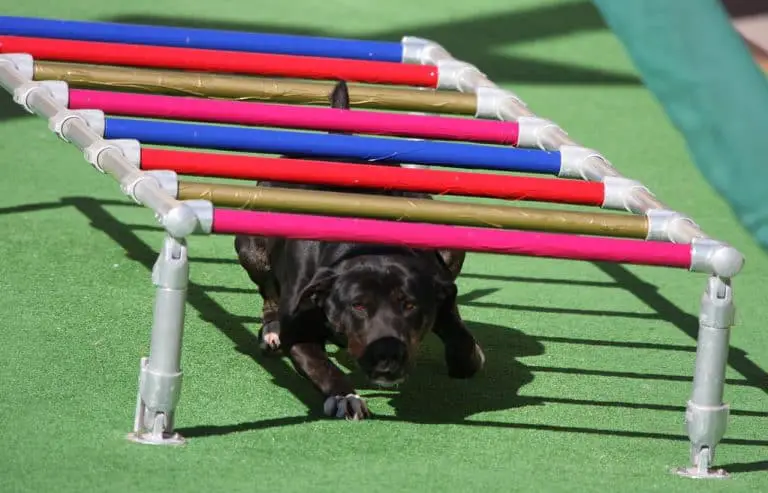In today’s fast-paced world, our furry friends deserve to have some fun and excitement right in the comfort of their own backyard. This blog post will guide you through creating a DIY dog agility course, packed with canine challenges that will not only provide exercise but also mental stimulation. We’ll explore the world of dog obstacle courses, agility training, and the joy of watching your pup navigate through a series of obstacles. So, let’s get started on your backyard agility adventure!
The Benefits of a Dog Obstacle Course

Physical Exercise
A backyard obstacle course for dogs offers a wide array of physical activities that are not only enjoyable but also essential for their overall health and well-being. Here’s why it’s so important:
- Cardiovascular Health: Running through tunnels, jumping over hurdles, and weaving through poles provide an excellent cardiovascular workout for your furry friend. This helps maintain a healthy heart and lung function, which is crucial for dogs of all sizes.
- Muscle Development: The various obstacles in an agility course target different muscle groups. Jumping builds leg strength, weaving enhances flexibility, and climbing improves upper body strength. This physical conditioning contributes to your dog’s strength and agility.
- Weight Management: Regular exercise on an obstacle course helps dogs maintain a healthy weight. Obesity is a common concern in pets, and physical activity is a key factor in preventing it.
- Joint Health: The activities on an obstacle course can be gentle on your dog’s joints, as they can control the intensity of their movements. This is especially important for older dogs or those with joint issues, as it allows them to stay active without straining themselves.
Mental Stimulation
In addition to physical exercise, mental stimulation is equally important for your dog’s overall well-being. Here’s why an agility course provides valuable mental challenges:
- Problem-Solving: Dogs are natural problem solvers. Navigating through obstacles and figuring out the best way to complete the course stimulates their cognitive abilities. It encourages them to think and strategize, which is essential for their mental development.
- Concentration and Focus: Agility training requires dogs to pay attention to their handler’s cues and navigate the obstacles with precision. This improves their ability to concentrate and stay focused, a valuable skill that can extend beyond the course.
- Bonding with Owners: Agility courses involve teamwork between you and your dog. You guide them through the course with voice and hand signals. This interaction strengthens the bond between you and your pet, creating a sense of trust and cooperation.
- Preventing Boredom: Dogs that lack mental stimulation can become bored and may develop behavioral issues. An agility course keeps their minds engaged and helps prevent destructive behaviors that often stem from boredom.
- Boosting Confidence: Successfully completing obstacles boosts your dog’s self-confidence. This can be especially beneficial for shy or anxious dogs, as it helps them build trust in their own abilities.
Planning Your Backyard Dog Obstacle Course

Before we dive into the fun part of setting up the course, let’s discuss how to plan and design it.
Assess Your Space
When assessing your space for a dog obstacle course, there are a few important considerations:
1. Yard Size: The size of your yard will dictate how elaborate your course can be. A larger yard allows for more obstacles and room for your dog to run, while a smaller yard might limit your options. Make the most of the available space.
2. Terrain: Take note of the terrain in your yard. Is it flat, hilly, or uneven? This will affect the placement of obstacles and the level of challenge for your dog.
3. Potential Hazards: Identify any potential hazards in your yard, such as sharp objects, toxic plants, or holes. Ensure you remove or secure these hazards before setting up the course.
4. Accessibility: Ensure that the course is easily accessible from your home. Dogs should be able to reach the course without any obstacles like stairs or tight spaces that might make it difficult for them.
5. Play Areas: Consider designating specific play areas for your dog, especially if you have kids or other family members using the yard for different activities. This can help maintain a safe separation between play zones.
Safety Considerations
Safety is paramount when creating a backyard dog obstacle course. Here are some key safety considerations:
1. Dog Runs or Enclosures: If you’re concerned about your dog wandering off or interacting with potential hazards outside the course, consider using dog runs or enclosures. These secure areas can keep your dog contained within the course area, providing a controlled environment.
2. Padded Surfaces: For some obstacles, like jumps and hurdles, using soft, padded surfaces can prevent injury if your dog stumbles or falls. Rubber mats or grass can act as cushioning.
3. Properly Secured Obstacles: Ensure that all obstacles are securely anchored in the ground to prevent them from toppling over while your dog is using them. Unstable obstacles can lead to accidents.
4. Supervision: Always supervise your dog when they are using the obstacle course, especially during the initial stages of training. This allows you to correct any unsafe behavior and provide guidance.
5. Regular Maintenance: Regularly inspect and maintain the obstacles and the course itself. Over time, wear and tear can occur, and it’s important to replace or repair any damaged components to keep the course safe.
Designing and Building Canine Challenges

Let’s get creative and start building some exciting obstacles for your pup. Here are a few ideas to consider:
Jump Obstacle
A jump obstacle can be easily made with PVC pipes or wooden planks. Adjust the height to match your dog’s size and agility level.
Weave Poles
Weave poles are a classic agility course element. You can create them using PVC pipes and traffic cones. Teach your dog to weave in and out of these poles.
Tunnel
Tunnels are a thrilling part of an agility course. You can buy one or create a DIY version using household items like a large box. Dogs love darting through tunnels!
Hurdles
Hurdles are simple to make with PVC pipes and cinder blocks. Adjust the height for your dog’s comfort, and watch them leap over these obstacles.
Training and Safety Guidelines
Now that you have your obstacles in place, it’s time to train your dog to navigate the course safely.
Positive Reinforcement
Use positive reinforcement techniques to encourage your dog. Reward them with treats, praise, and plenty of love when they complete an obstacle.
Start Slowly
Begin with the basics and gradually introduce more challenges as your dog becomes more confident. This will build their skills and confidence.
Fun Activities for Your Dog Obstacle Course

Creating an agility course isn’t just about training; it’s also about having fun with your furry friend.
Agility Competitions:
Agility competitions are a fantastic way to take your dog’s backyard obstacle course to the next level. These competitions can be an absolute blast for both you and your furry friend. Invite friends and their dogs over for a friendly contest, and you’ll be amazed at how the dynamics change. The sense of competition can bring out the best in your dog’s agility skills.
It’s not just about showcasing your dog’s talents; it’s about bonding with fellow dog lovers and sharing in the joy of watching these four-legged athletes in action. These events can be a wonderful way to build a sense of community among dog owners in your area. Just remember to keep it light and fun; it’s not about winning or losing but about the joy of watching your dogs thrive in an active and social setting.
Kids and Dogs
Getting your kids involved in the agility course is a fantastic family activity. It not only allows your kids to bond with your dog but also teaches them responsibility and empathy. It’s an opportunity for them to actively participate in their pet’s well-being. As they help train the dog and run through the course together, it fosters a sense of teamwork and companionship that can be incredibly rewarding for both the child and the pet.
It’s also a great way to keep kids engaged and active, promoting a healthy lifestyle from an early age. Moreover, the experience of training and playing with dogs helps kids develop important life skills like patience, communication, and problem-solving. Overall, involving your kids in the agility course adds an extra layer of fun and learning to the entire experience, creating cherished family memories.
Final Thoughts: Backyard Obstacle Course for Dogs
In conclusion, a backyard obstacle course for dogs is a fantastic way to provide exercise, fun, and mental stimulation for your furry companion. By following these tips and getting creative with your agility course, you can create a space where your dog can thrive and have a blast. So, get those pvc pipes and cinder blocks, and start building your DIY dog agility course today. Your pup will thank you with wagging tails and joyful leaps!
Other suggested articles:

